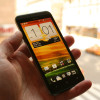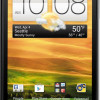Review: HTC EVO 4G LTE for Sprint
Screen
The EVO has a 4.7-inch Super LCD with 1280 x 720 pixels. That makes it an HD display, and a bright and colorful one at that. The pixel density is tight enough that picking out individual pixels is difficult. Everything rendered on the display is smooth and free of distracting rough edges. I used the device outside for an entire weekend and had no problem reading the display in direct sunlight. All the menus, screens, and apps were perfectly visible. It is a really, really good display.
Signal
The EVO will be one of the first few devices able to access Sprint's LTE network. That network is not yet available, and won't be for another month or two. That means we were only able to test the EVO's CDMA-EVDO Rev. A 3G radio (heh, yep, they still exist). To put it bluntly, it stinks. Sprint's 3G network isn't nearly as strong as Verizon's (which uses the same technology) and badly lags the speeds available to devices on T-Mobile's HSPA+ network and AT&T's HSPA+/LTE networks.
The phone itself performed on par with other Sprint devices I've tested in the metropolitan New York area. In my office, the EVO collected two bars of coverage and lost the network entirely in my basement (that means no data, no voice calls). When under strong network availability, the EVO did just fine connecting voice calls, but wireless data was never better than 1Mbps on the download and averaged closer to 500Kbps. Calls never dropped, but data often slowed to a temper-tantrum-erupting crawl.
Sound
Call quality with the EVO was not the greatest I've experienced. There was static and interference across the board on all phone calls, though it wasn't terrible by any stretch. Sprint is set to debut HD Voice later this year, which will dramatically improve voice quality. The one bummer is that it relies on 1X Advanced to work, which will have a very limited footprint over the next few months. Sprint demoed this feature for us at CTIA, and it was quite impressive. Without HD Voice, the earpiece was just barely adequate with respect to volume. When set all the way up and pressed hard to your ear, you'll be able to hear calls in most environments — even noisy ones. Those with whom I spoke that I sounded good, and reported a clean signal coming from my end of the conversation. If the volume is set to anything less, and you'll have trouble. The speakerphone isn't so good. You can hear all the same interference, and the volume oomph just isn't there. It's too quiet. You'll be able to use it in a quiet office or hotel room no problem, but any place that has even a modicum of noise will overpower the speakerphone. Ringers and alert tones are loud enough, but the vibrate alert is way too weak. Not once did the vibrate alert actually alert me to anything.
Battery
Since we tested the EVO under 3G-only conditions, battery life was quite good. We expect this to change once Sprint's LTE network launches. With the 3G and Wi-Fi radios on, I easily got more than a full day of life from the EVO. The question is just how much will Sprint's LTE network impact battery life?


 Hands-On: HTC EVO 4G LTE
Hands-On: HTC EVO 4G LTE
 Sprint's Latest EVO from HTC Adds 4G LTE, Brings Back Kickstand
Sprint's Latest EVO from HTC Adds 4G LTE, Brings Back Kickstand
 HTC EVO 4G LTE
HTC EVO 4G LTE



